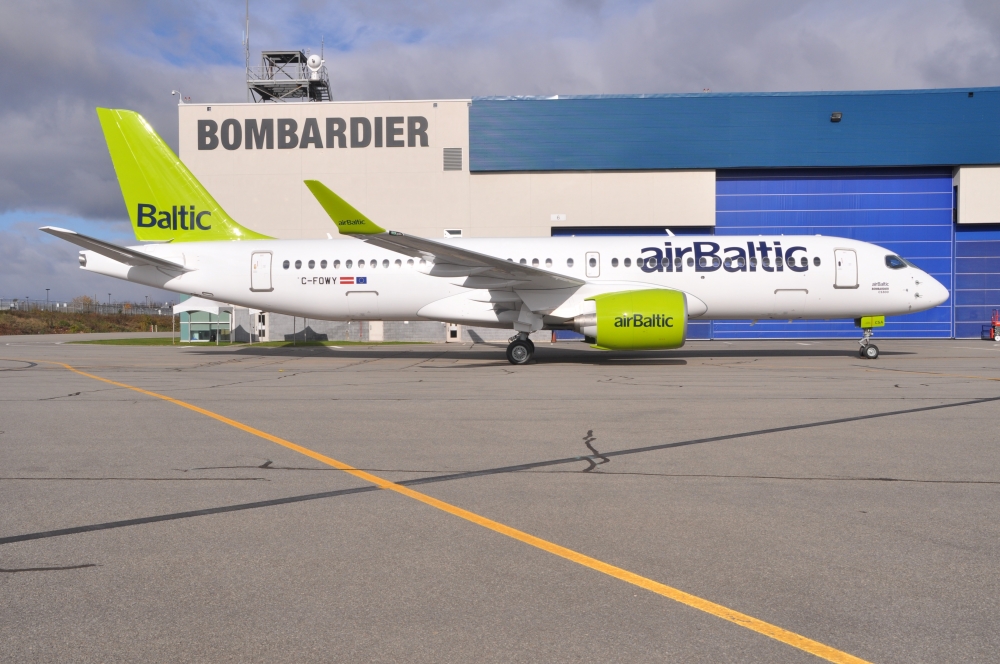Latest Bombardier jet delivered to Air Baltic
30 November, 2016
6 min read
By joining our newsletter, you agree to our Privacy Policy


Nothing about flight BT9801 is ordinary, including its scheduled departure time of 2am local time from Montréal on Tuesday.
This is the delivery flight of the first stretched C Series model and at 12:30am the complement of 18 souls about to fly over the Atlantic are gathered at the delivery centre at Bombardier’s Mirabel plant.
The first Bombardier C series CS300, previously known as MSN 55003 and now registered as YL-CSA, has already been test flown for about 20 hours and it is ready to head to its new home.
By 2.23am, and after some last-minute issues are resolved, the aircraft is now officially operated by Air Baltic, the national carrier of Latvia in the Baltic region of north-eastern Europe.
There is a short briefing from senior vice president operations Pauls Calitis, who tells those aboard six of the 18 on board are pilots — three from Air Baltic and three from Bombardier — who will take turns in the cockpit.
Flight time to Stockholm’s Arlanda airport is estimated at six hours and 40 minutes on a slightly longer than normal route because the the C Series is not yet certified for extended range twin-engine operations, or ETOPS.
The cabin is lit in Air Baltic’s corporate green and offers an impressive first sight as the passengers enter from the darkness outside. It also instantly showcases the impact of the mood-lighting system with which this aircraft is equipped.
Air Baltic is the first airline ordering mood-lighting on the C Series and it underscores the fact that the Bombardier jet is a serious airliner along the lines of those produced by Airbus or Boeing.
Even the cabin appearance resembles the latest long-haul jets such as A350 and B787: much bigger windows and a high ceiling contribute to a wide-body feeling, even though the C Series is a single-aisle aircraft with 2+3 seating.
Air Baltic has equipped its cabin with 145 “SlimPlus” seats manufactured by Zodiac. The seats are clad in leather of a light grey, almost whitish colour that might be prone to staining after some time of heavy-duty utilization. At present, however, they are pristine and look stylish.
Despite a pitch of 30 inches (76.2cm), the seats feel roomy thanks to their slim architecture.
The middle seats on the right side of the cabin are even wider at 19 inches, while , while all other seats boast a generous width of 18.5’’, compared to widths on some aircraft of 17 inches.
Air Baltic’s seats allow a considerable recline, with the whole seat pan moving forward and upwards, minimizing the impact for the passenger sitting behind.
This seems to be a win-win and huge advantage over the dreaded “pre-reclined” seats with fixed seatbacks that many low cost carriers use and which are now seeping into network carrier’s cabins on airlines such as TAP, Air Portugal and some Air France Airbus aircraft.
Air Baltic has opted not to use different seating for business class — which Bombardier proposes in a 2+2 layout with a 36-inch pitch — but rather has stitched “Seat not to be occupied” signs on the aisle seat of the left and the middle seats on the right side in the first three rows. A curtain that will divide both cabins had yet to be installed.
This is a no-fuss flight with no seat assignments or boarding passes, not to mention a lack of any security checks or passport control before boarding.
Instead, the 16 people riding in the cabin are asked to congregate aft of the wings for take-off so the weight is spread more more evenly in the largely empty cabin. At 3:57 am Montreal time, the engines finally come to life but the noise is subdued in the cabin.
Start-up, which can take minutes otherwise, is a pretty swift affair as the engines were doing run-ups just prior to the flight.
“We don’t have the same problems with the new Geared Turbofan engines as Airbus A320neo operators complain about, as they use the different PW1100G and we the PW1500G”, explains Air Baltic chief pilot Gerhard Ramcke.
At 4:13 am , over two hours late, it’s wheels up for flight BT9801 bound for Stockholm. Takeoff weight today is 57 tons, ten tons short of the CS300’s maximum take-off weight (MTOW).
Two hours later, as the flight heads east over the coast of Newfoundland, the sun rises to the right of the aircraft. The route takes the aircraft to the south of the southern tip of Greenland. Snowy mountain peaks and deep fjords lie 41,000 feet below in pristine sunshine in an orange glow.
After about three and a half hours of daylight, the sun sets again, while shortly later, the aircraft flies over Norway, coming into Stockholm Arlanda at 4:54 pm central European time after a flight time of exactly 6 hours, 40 minutes and 39 seconds.
The CS300, such as the three CS100s already in service with Swiss, has clearly proven why it will become a favourite with passengers and airlines.
It is even well suited for long-haul operations, although this won’t be its mission, and the 5,800 km journey from Montréal to Stockholm is well within the range of a CS300 with a full passenger load.
Bombardier puts its range of the aircraft at 6,112 km (3,300 nm) but Air Baltic will put it on short European hops, starting with Riga to Amsterdam on December 14 for the first scheduled flight.
Before that, it will tour four important neighbouring markets on demonstration flights for invited guests, with stops planned in Tallinn, Vilnius, Helsinki and Hamburg.
The airline already has 12 pilots certified to fly the CS300, and it will receive the second of 20 ordered aircraft before the end of the year, putting it into service in January.
On Wednesday morning, the aircraft made a last short hop to Riga, landing in time for a huge welcome party attended by the President of Latvia.
Follow Andreas on @SpaethFlies
Next Article
2 min read
Qantas triples profit but misses mark

Get the latest news and updates straight to your inbox
No spam, no hassle, no fuss, just airline news direct to you.
By joining our newsletter, you agree to our Privacy Policy
Find us on social media
Comments
No comments yet, be the first to write one.

